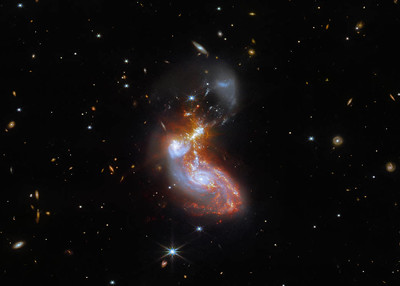 //embedr.flickr.com/assets/client-code.js
//embedr.flickr.com/assets/client-code.js
When I look at images like this one from the James Webb Space Telescope of two galaxies “merging” I think about how impossible it is that our species will ever reach the stars. I do not like how pessimistic I have become, but I have seen what humans are capable of, and most of it is not good. And it seems to make no difference whether you look at someone who comes from a “good family” or is religious or anything we usually consider a positive attribute. We’re totally divided in our civilization, and politics and religion are making things worse. I don’t see any possibility of unifying humanity for the purpose of being worthy to be a space-faring species. We cannot even agree on how to address the problems we have on earth, like infectious diseases, poverty, homelessness, and food security. When we have solved those problems and so many others, we might be capable of looking to the stars.
Science fiction tells us how the future might look, but we can’t possibly imagine our future. Notice how all the movies depicting the future failed to predict that every person would be carrying mobile networked computers in their pockets and purses. These devices have more processing power than the on-board computer on Apollo XI. Of course technology advances so rapidly no one could have predicted any of this. Our civilization has managed to extend life expectancy (except for the past couple years of COVID-19). However, there are still hundreds of millions of people who lack access to clean water. We seem to have the ability to take a step forward and then two steps backward. On the other hand, our worlds population just reached 8 billion people. Do we have any business traveling to outer space? Doesn’t it seem like we’re running away form our problems?
Besides, the vast distances between stars means no one person can live to see the end of the journey. The Pillars of Creation are located 6,500 light-years from earth, but still within our own Milky Way galaxy. That distance would mean that since the rise and fall of the ancient Egyptian civilization light has traveled from those stars to reach our planet. Humans will probably never be able to travel that fast. So we’ll have to live on ships that could sustain generations of travelers, whose descendants would eventually settle on a new planet warmed by a distant star. Other galaxies? They are much, much farther. If you look closely you can see galaxies in the background, perhaps long gone by now. Who were they, all those planets circling all those suns? Will those remote peoples ever hear about our greatest civilizations? Likely not. So much has already been lost in the cosmic emptiness between galaxies.
In the next 400 years, or let’s make it 1,000 years, what will become of human civilization? Will we have traveled to Mars or beyond? Will space-arks be transporting people and their beasts to some alien planet where they will start over? I will leave the speculation to science fiction writers. Those distant galaxies are in the realm of the artists and the dreamers. Perhaps one day a million years in our future something that used to be human will visit one of those galaxies in the picture. It won’t be anything resembling me or any other person living today, just as we are far removed from our most distant ancestors. Lucy and her family could not possibly imagine us and our world. So we can imagine that “day”, but we wouldn’t get it right.
But the pictures are pretty cool.